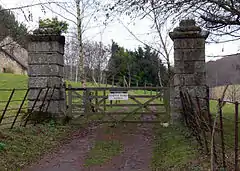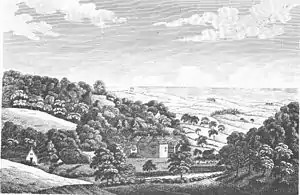Knighton Gorges Manor
Knighton Gorges Manor was one of the grandest manor houses on the Isle of Wight. Located in the hamlet of Knighton, near Newchurch, it is reported to be one of the most haunted locations on the Isle of Wight.
| Knighton Gorges Manor | |
|---|---|
 Entry gate posts of the demolished Knighton Gorges Manor | |
 Location within Isle of Wight | |
| General information | |
| Architectural style | Tudor architecture |
| Town or city | Near Newchurch, Knighton, Isle of Wight |
| Country | England |
| Coordinates | 50°39′52″N 1°12′30″W |
| Construction started | 12th Century |
| Demolished | 1821 |
| Technical details | |
| Structural system | Brick |

The Elizabethan-Tudor style house's history has been a saga of tragic events. It started with a ghastly note of Hugh de Morville, an escapee who resided there after murdering Archbishop Thomas Becket of Canterbury, on 27 December 1170, along with his three other comrades in crime Reginald Fizure, Richard Brito and William Tray, then the death of Tristram Dillington in 1718 under mysterious circumstances and finally, 100 years later, followed by another tragic event of the owner of the Manor, George Maurice, destroying the manor in 1821 on his own volition (before his death), purely as a parental annoyance and spiteful action, to his daughter marrying a clergyman, against his wishes thus preventing her from owning the manor.[1][2][3]
These events have also generated reportedly paranormal events occurring at the manor location, witnessed in the form of the destroyed manor house itself appearing in an apparition form, ghost of Sir Tristram riding a ghostly horse each year on the anniversary of his death, and sighting of animal-like gargoyles on top of each gatepost at the entrance to the manor site.[4]
History
Sir Hugh de Morville(d.1202) fled to the house after taking part as 1 of 4 knights in the murder on 29 December 1170 of Thomas Becket, Archbishop of Canterbury. He fled thence to Knaresborough Castle, Yorkshire, which was held by him. The manor was owned by the de Morvilles until 1256 when Ralf de Gorges acquired it by marriage, which is where the name Knighton Gorges comes from.[2] The early 13th-century holders were a family of De Morville, of whom John or Ivo de Morville died in 1256, leaving a daughter and heir Ellen married to Ralph de Gorges, who survived her husband and was in possession of the manor at the end of the century. [1]
She died in 1291–2, leaving a son Ralph, who in 1305 leased the manor to William de Caleshale and his wife for the term of their lives. The manor seems to have reverted to Ralph de Gorges before 1316. Ralph (afterwards Sir Ralph) and his wife Eleanor had one son Ralph, who died without issue, evidently before 1330–1, when Sir Ralph settled the manor in tail-male on two younger sons of his daughter Eleanor, who had married Theobald Russell of Yaverland.[1]
William, the elder of the two, died without issue and the manor was delivered to his brother Theobald Russell in 1343. He appears thereupon to have assumed the name de Gorges, and as Theobald de Gorges was sued in 1346–7 by Elizabeth widow of Ralph de Gorges the younger for the manor.[1] Judgement was given in Elizabeth's favour, but as she had no issue by Ralph the manor reverted to Theobald, who was in possession in 1362. He (then Sir Theobald) died in 1380 and the manor passed successively to his sons Sir Randolf, who died in 1382, Bartholomew, who died in 1395–6, and Thomas, who died in 1404.
Thomas left a son John, who only lived to be fifteen, and left his brother Theobald, a boy of ten, as heir in 1413. Sir Theobald Gorges was in possession of the manor in 1462, and probably died without issue, as the manor passed to the heirs of Thomas Russell, greatgrandson of Theobald Russell and Eleanor de Gorges by their eldest son Ralph Russell of Yaverland.[1] Thomas Russell's heir was his cousin John Haket, son of his aunt Alice. John Haket's daughter and heir Joan married John Gilbert, and the manor passed with Wolverton in Brading in the Gilbert family until 1563, when George Gilbert sold it to Anthony Dillington. Anthony's son Sir Robert died in 1604, leaving it to his nephew Robert. Sir Tristram Dillington, great-grandson of the lastnamed Robert, was the last of the direct line.[1]
Dying without issue in 1721, Tristram left his sisters Mary and Hannah as heirs. Hannah died intestate. Mary died unmarried, leaving the estate in common between her nephew Maurice Bocland and her niece Jane wife of John Eyre. General Maurice Bocland was in possession of the manor in 1750 and died in 1765, when it descended to his nephew George Maurice Bissett, who held the manor at the beginning of the 19th century. In 1820, the house was burnt and demolished by Bisset,[1] and has not been rebuilt.
George Young was in possession of the remaining estate in 1878,[1] and the land as of 1912 was held by Mr. Edward Carter, who acquired it under the will of his father, also named Edward.[1]
The site of the house is now private, and a holiday cottage exists upon the estate in one of the remaining outbuildings.[5]
Architecture

The house was a remarkably good example of Tudor work.[1] All that is now left of the house is the two stone gateposts as the house was burnt and demolished in 1820 by George Maurice Bisset to prevent his daughter inheriting it after she had married a clergyman without Bisset's consent.[1]
The manor facing north had large square windows (no painted glass windows), which are divided by stone mullions. The rooms were of large size and elegantly designed. The drawing room on the first floor was a capacious room with a long gallery in the north front. Lighting in the house was poor as it had a low roof. A coat of arms dated older than the manor house also decorated the windows.[3]
In its hay days the manor house was visited by Sir Henry of England who gave detailed description of the manor in his "History of the Isle of Wight". It was the favoured haunt of the fashionable society of artists, writers and administrators including Sir Richard Worsley, Captain of the Isle of Wight, the latter's association resulted in a scandal and disgrace.[3]
Haunting
Knighton Gorges is a cornerstone of the local ghost-story industry, as the house has long been said to reappear at times in ghostly form.[6][7] Several books including The Ghosts of Knighton Gorges have been published especially covering the ghosts of the manor. Locals have also reported seeing animal-like gargoyles on top of each gatepost; these figures, if ever they existed, were removed many years ago and all that is left is plain stone.[8] Further along the road to the south near the old waterworks there are identical pillars from the former Knighton Gorges upon which the owner has placed modern gargoyles. As there have been many stories of the ghostly reappearance of these statues, alleged sightings may be due to the confusion created thereby.
The area is said to be haunted by various ghosts and is a popular stop for ghost tourists. One story often told is that of Sir Tristram Dillington, M.P. for Newport, who is thought to have committed suicide after taking to gambling heavily after the death of his wife. His valet is said to have concealed the nature of his death by placing his corpse upon his horse, Thunderbolt, and driving it into the lake, ensuring that the property was not forfeited (so that an inquest could be avoided).[8][9] The story is that the ghost of Sir Tristram rides a ghostly horse each year on the anniversary of his death, which occurred on 7 July 1721.[10]
Sightings of a man standing next to the fence next to the water works, and a lady dressed in a dark ankle length frock by the entrance pillars have recently been recorded by the shepherd and witnessed by passers by. Electrical equipment notably cameras have failed to operate in certain corners of the estate.
References
This article includes text incorporated from William Page's "A History of the County of Hampshire: Volume 5 (1912)", a publication now in the public domain
- "Victoria County History". British History Online, University of London & History of Parliament Trust. 1912. Retrieved 6 July 2011.
- Lloyd, David Wharton; Pevsner, Nikolaus (2006). The Isle of Wight. Yale University Press. ISBN 978-0-300-10733-3. Retrieved 6 July 2011.
- "Knighton Gorges Isle of Wight". Psychicrealmssuppliers. Archived from the original on 6 March 2011. Retrieved 7 July 2011.
- "Knighton Gorges". Haunated Locations. Archived from the original on 3 April 2011. Retrieved 7 July 2011.
- "Knighton Gorges Holiday Cottage". Island Cottage Holidays. Retrieved 17 February 2018.
- "The Phantom House, The Strange Story or Knighton Gorges, By Jessie Middleton" (PDF). Archived from the original (PDF) on 16 July 2011. Retrieved 6 July 2011.
- "A brief manifestation of the hauntings and strange events that surround the villages and buildings on this enchanted isle". Wight Ghosts. Archived from the original on 15 June 2011. Retrieved 7 July 2011.
- Ghost Club
- William Henry Davenport Adams (1856). The history, topography, and antiquities of the isle of Wight. Smith, Elder, and Co. pp. 111–. Retrieved 7 July 2011.
- "Leigh Rayment: constituencies". Archived from the original on 7 November 2017. Retrieved 6 July 2011.